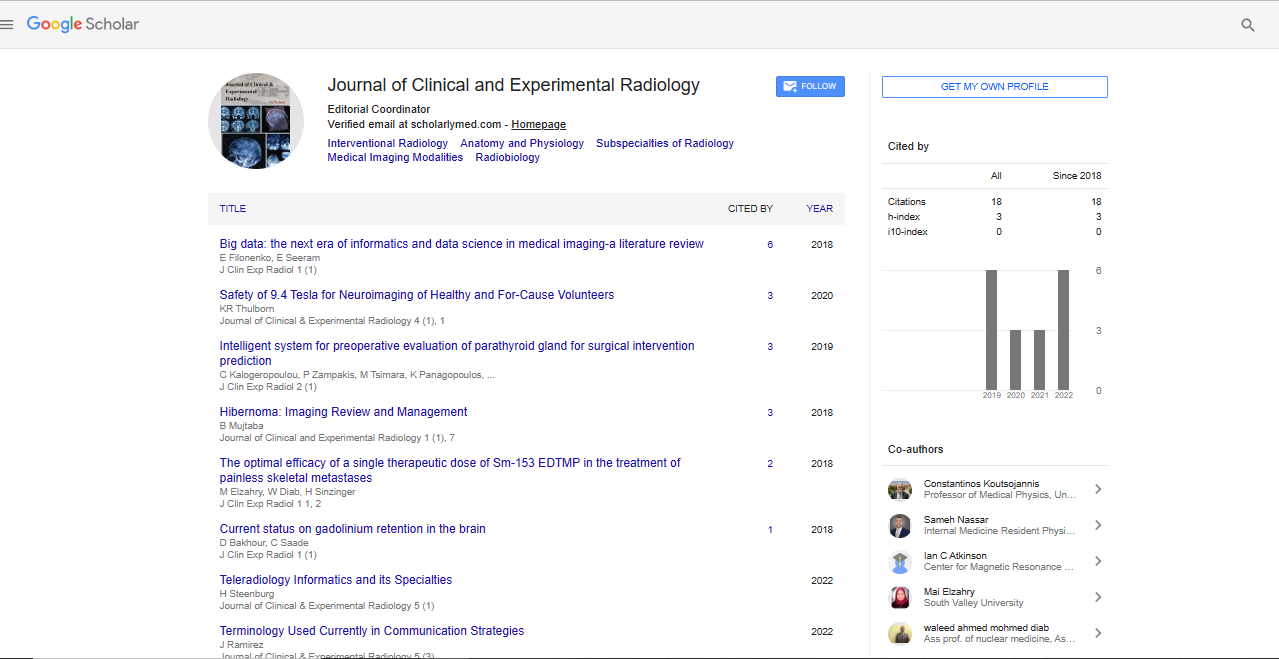Perspective, J Clin Exp Radiol Vol: 6 Issue: 2
Advancements in Molecular Imaging for Disease Diagnosis
Teraa Fabien*
1Department of Vascular and Endovascular Surgery, Asklepios Medical School Hamburg, Hamburg, Germany
*Corresponding Author: Teraa Fabien,
Department of Vascular and
Endovascular Surgery, Asklepios Medical School Hamburg, Hamburg, Germany
E-mail: teraa@fab.edu
Received date: 28 May, 2023, Manuscript No. JCER-23-106875
Editor assigned date: 31 May, 2023, Pre QC No. JCER-23-106875 (PQ);
Reviewed date: 14 June, 2023, QC No. JCER-23-106875
Revised date: 22 June, 2023, Manuscript No. JCER-23-106875 (R);
Published date: 28 June, 2023, DOI: 07.4172/jcer.1000142
Citation: Fabien T (2023) Advancements in Molecular Imaging for Disease Diagnosis. J Clin Exp Radiol 6:2.
Description
Molecular imaging is a rapidly evolving field that combines imaging technology and molecular probes to visualize and analyze biological processes at the molecular and cellular levels. It offers a unique window into the inner workings of living organisms, enabling researchers and clinicians to gain valuable insights into disease mechanisms, evaluate treatment responses, and develop targeted therapies. Over the years, significant advancements have been made in molecular imaging techniques, enhancing their sensitivity, specificity, and versatility. This study discuss some of the key advancements in molecular imaging techniques and their potential applications in research and clinical practice.
One major advancement in molecular imaging is the integration of multiple imaging modalities. By combining the strengths of different techniques, such as Positron Emission Tomography (PET) with Magnetic Resonance Imaging (MRI) or Computed Tomography (CT), researchers can obtain comprehensive and complementary information about molecular targets, anatomical structures, and functional parameters. Multimodal imaging improves the accuracy of molecular target localization, facilitates the identification of co-occurring abnormalities, and enhances the overall diagnostic capability of molecular imaging. Another significant advancement is the improvement in spatial resolution. High-resolution imaging techniques allow for the visualization of smaller structures and finer details, which is particularly valuable in the study of cellular processes and microenvironments. Advances in hardware and image reconstruction algorithms have enabled the development of imaging systems with enhanced spatial resolution, leading to improved image quality and better delineation of molecular targets.
The development of novel molecular probes has revolutionized molecular imaging. These probes are specifically designed to target and bind to molecular markers associated with various diseases, such as cancer, cardiovascular disorders, and neurodegenerative conditions. These probes can be labeled with radioisotopes, fluorescent dyes, or other imaging agents, allowing for their detection and quantification within the body. Novel molecular probes enable researchers to visualize specific biological processes, track disease progression, and assess treatment responses with high sensitivity and specificity.
Advancements in functional imaging techniques have expanded the capabilities of molecular imaging. Functional imaging allows for the assessment of physiological processes, such as blood flow, metabolism, and receptor interactions. Techniques like dynamic PET imaging, which captures temporal changes in radiotracer distribution, provide valuable insights into the kinetics of molecular interactions and can aid in the evaluation of treatment responses. Functional imaging techniques enhance our understanding of disease mechanisms and provide quantitative measures of treatment efficacy.
Molecular imaging has also found applications in image-guided interventions. By integrating molecular imaging techniques with interventional procedures, such as biopsies, surgeries, and targeted therapies, clinicians can improve the accuracy and precision of these interventions. Molecular imaging provides real-time feedback on the location and extent of disease, enabling more targeted and effective treatment delivery. It also facilitates the monitoring of treatment responses, allowing for timely adjustments in therapeutic strategies.
The integration of imaging informatics and Artificial Intelligence (AI) has opened up new possibilities in molecular imaging. AI algorithms can analyze large volumes of imaging data, extract relevant features, and assist in pattern recognition and decision-making. These tools can aid in the detection and characterization of molecular targets, improve image reconstruction and quantification, and facilitate image interpretation and analysis. AI-based approaches have the potential to enhance the efficiency and accuracy of molecular imaging, leading to more precise diagnoses and tailored treatment strategies.
Theranostics is an emerging field that combines diagnostics and therapeutics. It involves the use of molecular imaging techniques to identify specific molecular targets and guide the delivery of targeted therapies. By incorporating theranostic approaches, clinicians can select the most appropriate treatment options based on individual patient characteristics and monitor the response to therapy in real-time. Theranostics has the potential to improve treatment outcomes, minimize side effects, and optimize patient care.
Advancements in molecular imaging techniques have transformed the field of molecular imaging and have immense potential in both research and clinical applications. The integration of multimodal imaging, high-resolution imaging, novel molecular probes, functional imaging, imaging informatics, and theranostics has enhanced the sensitivity, specificity, and versatility of molecular imaging. These advancements provide researchers and clinicians with powerful tools to better understand disease processes, evaluate treatment responses, and develop personalized treatment strategies. As technology continues to advance, it is expected that molecular imaging techniques will play an increasingly important role in precision medicine, leading to improved patient outcomes and more effective healthcare interventions.
 Spanish
Spanish  Chinese
Chinese  Russian
Russian  German
German  French
French  Japanese
Japanese  Portuguese
Portuguese  Hindi
Hindi 